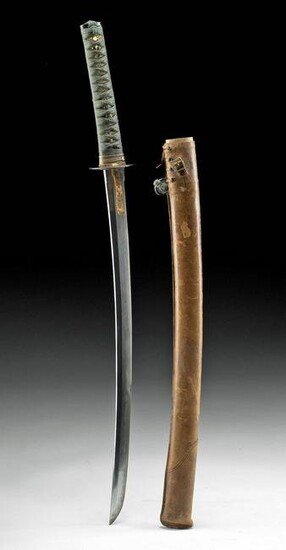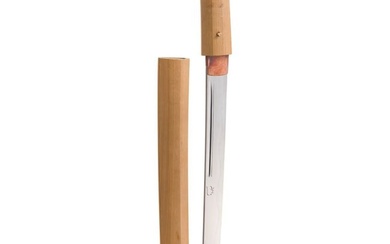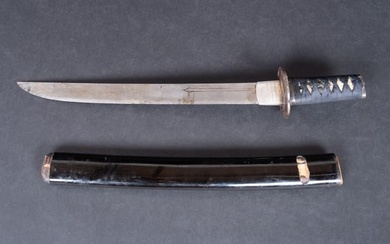Japanese Edo Wakizashi Blade & WWII Leather Scabbard
East Asia, Japan, Edo Period, ca. 1650 CE; World War II era, ca. 1939 to 1945 CE. A beautiful wakizashi with an Edo period steel blade and handle fitted within a WWII-era, leather-wrapped scabbard (saya). The wooden handle (tsuka) is wrapped with stingray skin (samegawa) and cotton straps (tsuka-ito) and adorned with a pair of copper dragon-form menuki. A horn cap (kashira) tops the handle, and a lower gilt copper cap exhibits a pair of Japanese arrow types. Separating the handle from the blade is a hand guard (marugata sukashi tsuba) adorned with an openwork flower. The shinogi-zukuri blade features a diamond-shaped (iori-mune) profile, a curved (chu-kissaki) tip, and a wavy (gunome) temper pattern formed by the tight-grained hammer-folding process (itame-hada). Compact swords of this type were common weapons carried by Japanese fighter pilots who needed to have a usable but condensed weapon that could fit within the cockpit of their aircraft. Size (w/ scabbard): 2.875" W x 31.5" H (7.3 cm x 80 cm); (blade): 21.25" L (54 cm)
This traditional Japanese sword was both a weapon and a symbol of authority and social status. The wakizashi paired with the longer katana sword marked the wearer as a samurai. The shorter sword was seen as an auxiliary weapon, also used for fighting in close quarters. In addition, Wakizashi could be worn by non-samurai if worn alone, and members of the merchant class (chonin) wore them because of the frequency of encountering bandits when traveling between Japan's cities.
Provenance: private Jones collection, Boulder, Colorado, USA; ex-private Sacramento, California, USA collection
All items legal to buy/sell under U.S. Statute covering cultural patrimony Code 2600, CHAPTER 14, and are guaranteed to be as described or your money back.
A Certificate of Authenticity will accompany all winning bids.
PLEASE NOTE: Due to recent increases of shipments being seized by Australian & German customs (even for items with pre-UNESCO provenance), we will no longer ship most antiquities and ancient Chinese art to Australia & Germany. For categories of items that are acceptable to ship to Australia or Germany, please contact us directly or work with your local customs brokerage firm.
Display stands not described as included/custom in the item description are for photography purposes only and will not be included with the item upon shipping.
#169087
Condition Report: Blade, hand guard, and handle are from the Edo period; fuchi, kashira, and leather scabbard are from the WWII era. Horn cap reattached beneath wrappings with light adhesive residue visible along underside. Minor abrasions to blade faces, with light oxidation to hand guard, and light abrasions to leather on sheath. Great patina throughout.
View it on
Estimate
Time, Location
Auction House
East Asia, Japan, Edo Period, ca. 1650 CE; World War II era, ca. 1939 to 1945 CE. A beautiful wakizashi with an Edo period steel blade and handle fitted within a WWII-era, leather-wrapped scabbard (saya). The wooden handle (tsuka) is wrapped with stingray skin (samegawa) and cotton straps (tsuka-ito) and adorned with a pair of copper dragon-form menuki. A horn cap (kashira) tops the handle, and a lower gilt copper cap exhibits a pair of Japanese arrow types. Separating the handle from the blade is a hand guard (marugata sukashi tsuba) adorned with an openwork flower. The shinogi-zukuri blade features a diamond-shaped (iori-mune) profile, a curved (chu-kissaki) tip, and a wavy (gunome) temper pattern formed by the tight-grained hammer-folding process (itame-hada). Compact swords of this type were common weapons carried by Japanese fighter pilots who needed to have a usable but condensed weapon that could fit within the cockpit of their aircraft. Size (w/ scabbard): 2.875" W x 31.5" H (7.3 cm x 80 cm); (blade): 21.25" L (54 cm)
This traditional Japanese sword was both a weapon and a symbol of authority and social status. The wakizashi paired with the longer katana sword marked the wearer as a samurai. The shorter sword was seen as an auxiliary weapon, also used for fighting in close quarters. In addition, Wakizashi could be worn by non-samurai if worn alone, and members of the merchant class (chonin) wore them because of the frequency of encountering bandits when traveling between Japan's cities.
Provenance: private Jones collection, Boulder, Colorado, USA; ex-private Sacramento, California, USA collection
All items legal to buy/sell under U.S. Statute covering cultural patrimony Code 2600, CHAPTER 14, and are guaranteed to be as described or your money back.
A Certificate of Authenticity will accompany all winning bids.
PLEASE NOTE: Due to recent increases of shipments being seized by Australian & German customs (even for items with pre-UNESCO provenance), we will no longer ship most antiquities and ancient Chinese art to Australia & Germany. For categories of items that are acceptable to ship to Australia or Germany, please contact us directly or work with your local customs brokerage firm.
Display stands not described as included/custom in the item description are for photography purposes only and will not be included with the item upon shipping.
#169087
Condition Report: Blade, hand guard, and handle are from the Edo period; fuchi, kashira, and leather scabbard are from the WWII era. Horn cap reattached beneath wrappings with light adhesive residue visible along underside. Minor abrasions to blade faces, with light oxidation to hand guard, and light abrasions to leather on sheath. Great patina throughout.





